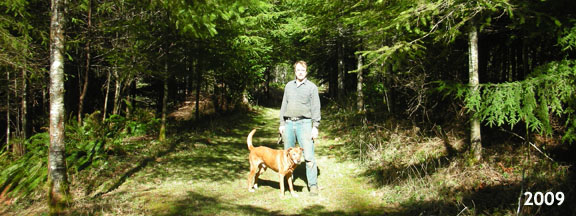|
Natural Forest Succession
|
|
Pig Meadow over 21 years
|
Just to the west of Ridgecrest Boulevard is Pig Meadow. It was the site of the most recent clearcut, around 1985, just a few years before the property was acquired. It was not replanted after harvesting, and continuous grazing since then kept the area open, leaving only stumps, ferns and grasses. In early 1988, a neighbor's lone 300-pound pig held court in the clearcut, and so it was named "Pig Meadow". By the end of that year, all the livestock was removed, new seedlings rapidly appeared and the transition back into forest had begun.
|
|
Natural Forest Succession
1:07 minute video about how the forest grew up in Pig Meadow over the past 21 years.
QuickTime: Get it Here Free
This Quicktime movie is 9 MB.
|
|
|
|
Ridgecrest Boulevard over 21 years
|
1988 Liza. Up to this time, goats grazed the high meadow, a wide open grassy field.
|
1999 John. No goat grazing over the past 10 years. Young fir trees up to 20 feet high and many bushes have grown up alongside the road and in the meadow.
|
2001 Robert and Nesta. Firs have been thinned and limbed up. New firs have been planted in the spaces to complete the promenade.
|
2009 John and Nesta. Before the firs have been limbed or trimmed.
|
|
|
 |
|
|
High Meadow over 21 years
|
When the property was acquired in 1987, the high meadow was being grazed by the neighbor's free-ranging sheep and goats. With no fences to contain the livestock, the animals foraged deep into the surrounding forest, creating an attractive pastoral landscape. Grazing livestock in a woodland is known as "Silvo-pasturing", as it achieves the dual purpose of growing trees while providing continuous forage for animals. Trees that make it above browsing height can achieve maturity, but relentless grazing prevents any tree regeneration and eliminates most brushy understory species. When the neighbor passed away in 1988, the animals were removed and the fringes of the high meadow started on the path to natural forest succession.
|
|
|
November 1987. An actively grazed woodland shows the attractive "parked-out" appearance that grazing and browsing livestock like sheep and goats create.
|
November 2001. 13 years after the livestock was removed, brush and brambles take over the pasture while the existing trees get bigger and new ones pop up.
|
February 2009. 21 years later, it has fully reverted to forest with grass found only in the mowed access roads. Some of the weak trees have been thinned out.
|
|

